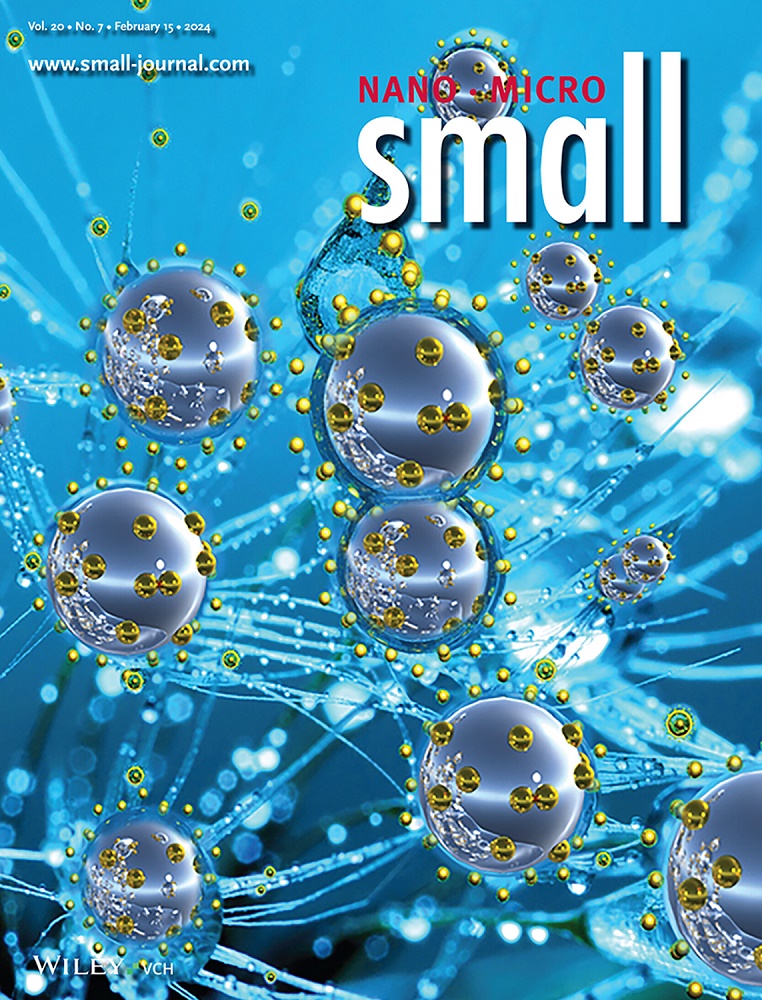探索Ho3+‐Yb3+和Nd3+‐Yb3+‐Ho3+掺杂LiLuF4纳米温度计的近红外成像:通过3D电子衍射阐明LiLuF4的结构
IF 12.1
2区 材料科学
Q1 CHEMISTRY, MULTIDISCIPLINARY
引用次数: 0
摘要
生物系统中的温度测量提供了有关癌症等疾病发生和位置的重要信息。此外,某些疗法依赖于肿瘤组织的局部加热,因此,对附近健康组织加热的反馈是有价值的。然而,传统的温度计不适合在生命系统中进行精确的温度检测。正因为如此,测量温度的替代方法,如基于发光的测温法,已经引起了人们的兴趣,并与医学诊断和治疗支持相关。在这项工作中,基于LiLuF4的纳米晶体被用于开发基于很少被探索的Ho3+‐Yb3+和Nd3+‐Yb3+‐Ho3+体系的新型比率温度计。在涂覆磷脂双分子层后,这些温度计在水中和模拟皮肤组织中表现出非常好的稳定性和测温性能。提出的Ho - Yb - Nd测温系统允许在一个激发波长下在一种材料内构建三个独立的温度计。由于迄今为止还没有报道过LiLuF4的白钨矿单晶结构,因此使用三维电子衍射分析(3D ED)确定了其单晶结构,采用高结晶纳米颗粒(<50 nm),这强调了3D ED确定无机纳米颗粒晶体结构的令人兴奋的潜力。本文章由计算机程序翻译,如有差异,请以英文原文为准。
Exploring Ho3+‐Yb3+ and Nd3+‐Yb3+‐Ho3+ Doped LiLuF4 Nanothermometers for NIR‐II Imaging: Elucidation of the LiLuF4 Structure via 3D Electron Diffraction
Temperature measurements in biological systems deliver important information about the occurrence and location of diseases such as cancer. Also, certain therapies rely on local heating of tumor tissue, and therefore, feedback on the heating of nearby healthy tissue is valuable. However, classical thermometers are not suitable for precise temperature detection in living systems. Because of this, alternative ways to measure temperature, such as luminescence‐based thermometry, have been gaining interest and relevance for medical diagnostics and treatment support. In this work, LiLuF4 ‐based nanocrystals are employed to develop novel ratiometric thermometers based on the rarely explored Ho3+ ‐Yb3+ and Nd3+ ‐Yb3+ ‐Ho3+ systems. After coating with a phospholipid bilayer, these thermometers show very good stability and thermometric performance in water and in skin‐mimicking tissue phantoms. The proposed Ho‐Yb‐Nd thermometry system allows constructing three separate thermometers within one material under one excitation wavelength. As there has been no scheelite single‐crystal structure of LiLuF4 reported to date, its single‐crystal structure is determined with the use of three‐dimensional Electron Diffraction analysis (3D ED) employing highly crystalline nanoparticles (<50 nm), which emphasizes the exciting potential of 3D ED for determining the crystal structure of inorganic nanoparticles.
求助全文
通过发布文献求助,成功后即可免费获取论文全文。
去求助
来源期刊

Small
工程技术-材料科学:综合
CiteScore
17.70
自引率
3.80%
发文量
1830
审稿时长
2.1 months
期刊介绍:
Small serves as an exceptional platform for both experimental and theoretical studies in fundamental and applied interdisciplinary research at the nano- and microscale. The journal offers a compelling mix of peer-reviewed Research Articles, Reviews, Perspectives, and Comments.
With a remarkable 2022 Journal Impact Factor of 13.3 (Journal Citation Reports from Clarivate Analytics, 2023), Small remains among the top multidisciplinary journals, covering a wide range of topics at the interface of materials science, chemistry, physics, engineering, medicine, and biology.
Small's readership includes biochemists, biologists, biomedical scientists, chemists, engineers, information technologists, materials scientists, physicists, and theoreticians alike.
 求助内容:
求助内容: 应助结果提醒方式:
应助结果提醒方式:


